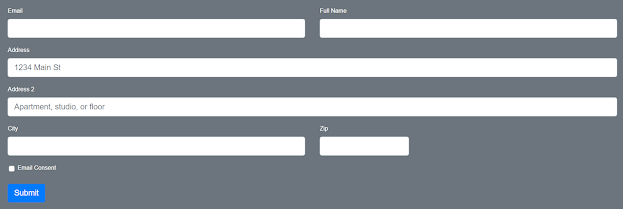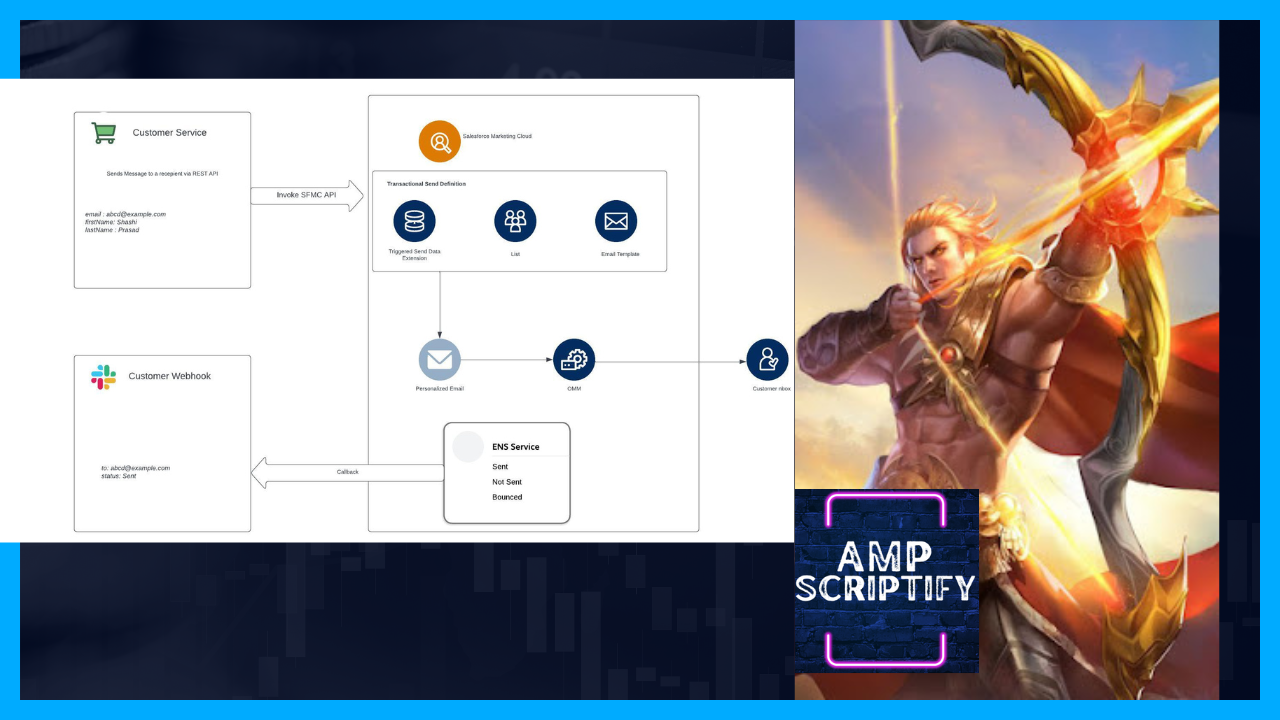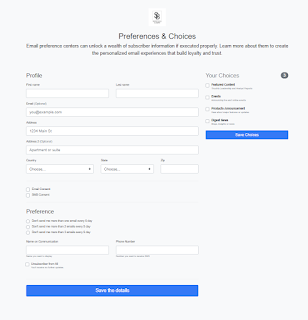Revolutionizing Distributed Marketing: Custom App Solutions for Seamless Data Extension Creation in Salesforce Marketing Cloud
Revolutionizing Distributed Marketing: Custom App Solutions for Seamless Data Extension Creation in Salesforce Marketing Cloud
Introduction:
In the dynamic realm of Distributed Marketing, the ability to create and manage template-based data extensions efficiently is paramount. These extensions serve as the foundation for personalized campaigns, ensuring brand consistency while empowering local marketers with the autonomy to tailor their messages to specific audiences. However, the process of creating these data extensions can often be cumbersome and prone to errors without the right tools in place. In this blog post, we'll explore how custom app solutions within Salesforce Marketing Cloud (SFMC) can streamline the creation of template-based data extensions for Distributed Marketing, enabling organizations to enhance their campaign effectiveness and drive meaningful engagement.
Challenges in Data Extension Creation for Distributed Marketing:
Traditionally, marketers tasked with creating template-based data extensions for Distributed Marketing campaigns have had to navigate through SFMC's native interfaces, which may lack the flexibility and user-friendliness required for efficient data modeling. This process often involves manually defining fields, setting up relationships, and configuring various properties, leading to potential inconsistencies and delays in campaign execution. Additionally, ensuring adherence to corporate branding guidelines and data governance policies further complicates the data extension creation process.
| Name | FieldType | MaxLength | IsRequired |
|---|---|---|---|
| greeting | Text | 255 | |
| id | Text | 254 | true |
| EmailAddress | true | ||
| sfCampaignId | Text | 255 | |
| sfCampaignMemberId | Text | 255 | |
| sfQuickSendId | Text | 255 | |
| sendFromName | Text | 255 | |
| sendFromEmail | Text | 255 | |
| firstName | Text | 50 | |
| lastName | Text | 50 | |
| sfUserId | Text | 255 | true |
| mobilePhone | Phone | ||
| journeyID | Text | 50 | true |
| sfOrgId | Text | 50 | true |
| smsValue | Text | 160 | |
| EntryObjectId | Text | 255 |
Custom App Solutions: Empowering Marketers with Efficiency and Control:
-
Streamlined User Interface:
Custom CloudPages provide marketers with user-friendly interfaces that simplify the process of defining data extension attributes and configurations. Interactive forms and guided workflows streamline the data modeling process, allowing marketers to specify field types, relationships, and other properties effortlessly. Real-time validation and feedback mechanisms help prevent errors and ensure data integrity, reducing the need for manual corrections and troubleshooting.
HTML Form
<form id="data-extension-form" action="%%=RequestParameter('PAGEURL')=%%" method="post"> <div class="form-group"> <label for="dataExtensionName">Data Extension Name</label> <input type="text" id="dataExtensionName" name="dataExtensionName" required> </div> <div class="form-group"> <label for="folderName">Folder Name</label> <input type="text" id="folderName" name="folderName" required> </div> <div class="form-group"> <input type="submit" value="Create Data Extension"> </div> </form>Client Side Scripting
<script> document.getElementById('data-extension-form').addEventListener('submit',consentSubmit); function consentSubmit(e){ try{ e.preventDefault(); var formData=new FormData(document.getElementById('data-extension-form')); var xhr = new XMLHttpRequest(); xhr.open('POST', 'https://cloud.domain/distributedMarketing', true); xhr.onload = () => { if (xhr.readyState === xhr.DONE) { if (xhr.status === 200) { // Check against the numeric status code console.log(xhr.response); console.log(xhr.responseText); // Reset the form fields after successful submission document.getElementById('data-extension-form').reset(); document.getElementById('success-message').style.display = 'block'; // Hide the success message after 3 seconds (3000 milliseconds) setTimeout(hideSuccessMessage, 3000); } } }; xhr.onerror = function(){ console.log("** An error occurred during the submission"); } xhr.send(formData); } catch(ex) { alert(ex.message); } } function hideSuccessMessage() { document.getElementById('success-message').style.display = 'none'; } </script>Full HTML
<!DOCTYPE html> <html lang="en"> <head> <meta charset="UTF-8"> <meta name="viewport" content="width=device-width, initial-scale=1.0"> <title>Create Distributed Marketing Data Extension </title> <link rel="stylesheet" href="https://cdnjs.cloudflare.com/ajax/libs/lightning-design-system/2.14.4/styles/salesforce-lightning-design-system.min.css"> <style> body { font-family: 'Arial', sans-serif; background-color: #f4f6f9; } .container { max-width: 500px; margin: 50px auto; padding: 20px; border-radius: 10px; box-shadow: 0px 0px 10px rgba(0, 0, 0, 0.1); background-color: #ffffff; position: relative; /* Required for logo positioning */ } .title { text-align: center; font-size: 24px; margin-bottom: 20px; color: #333333; } .form-group { margin-bottom: 20px; } label { font-weight: bold; display: block; margin-bottom: 5px; color: #666666; } input[type="text"], select { width: calc(100% - 12px); padding: 10px; border: 1px solid #cccccc; border-radius: 5px; box-sizing: border-box; font-size: 16px; } select { cursor: pointer; } input[type="submit"] { background-color: #0070d2; color: #ffffff; padding: 12px 20px; border: none; border-radius: 5px; cursor: pointer; font-size: 16px; transition: background-color 0.3s; width: 100%; display: block; } input[type="submit"]:hover { background-color: #005fb2; } .logo { position: absolute; top: 10px; left: 10px; width: 150px; height: auto; } .success-message { background-color: #d4edda; color: #155724; border: 1px solid #c3e6cb; border-radius: 5px; padding: 10px; margin-top: 20px; display: none; } </style> </head> <body> <div class="container"> <img class="logo" src="https://www.salesforce.com/news/wp-content/uploads/sites/3/2021/05/Salesforce-logo.jpg" alt="Salesforce Logo"> <h2 class="title">Create Distributed Marketing Data Extension </h2> <form id="data-extension-form" action="%%=RequestParameter('PAGEURL')=%%" method="post"> <div class="form-group"> <label for="dataExtensionName">Data Extension Name</label> <input type="text" id="dataExtensionName" name="dataExtensionName" required> </div> <div class="form-group"> <label for="folderName">Folder Name</label> <input type="text" id="folderName" name="folderName" required> </div> <div class="form-group"> <input type="submit" value="Create Data Extension"> </div> </form> <div class="success-message" id="success-message"> Data Extension created successfully! </div> </div> <script> document.getElementById('data-extension-form').addEventListener('submit',consentSubmit); function consentSubmit(e){ try{ e.preventDefault(); var formData=new FormData(document.getElementById('data-extension-form')); var xhr = new XMLHttpRequest(); xhr.open('POST', 'https://cloud.domain/distributedMarketing', true); xhr.onload = () => { if (xhr.readyState === xhr.DONE) { if (xhr.status === 200) { // Check against the numeric status code console.log(xhr.response); console.log(xhr.responseText); // Reset the form fields after successful submission document.getElementById('data-extension-form').reset(); document.getElementById('success-message').style.display = 'block'; // Hide the success message after 3 seconds (3000 milliseconds) setTimeout(hideSuccessMessage, 3000); } } }; xhr.onerror = function(){ console.log("** An error occurred during the submission"); } xhr.send(formData); } catch(ex) { alert(ex.message); } } function hideSuccessMessage() { document.getElementById('success-message').style.display = 'none'; } </script> </body> </html> -
Automated Backend Logic:
Leveraging Code Resources, organizations can automate the creation of template-based data extensions using predefined configurations and best practices. Custom logic orchestrates the generation of data extensions based on user input, automating tasks such as field creation, primary key assignment, and relationship establishment. Error handling and validation routines detect and resolve issues proactively, minimizing disruptions and ensuring consistent data extension structures across campaigns.
Request Parameters capture
%%[ /*-----Start Initialize the variables----------------*/ set @folderName=RequestParameter('folderName') set @dataExtensionName=RequestParameter('dataExtensionName') /*---------------------End-----------------------------*/ ]%%Folder ID Retrieve
// Function to retrieve folder ID by name function RetrieveFolderID(folderName) { var filter = { Property: "Name", SimpleOperator: "equals", Value: folderName }; var results = Folder.Retrieve(filter); return results[0].ID; // Return the ID of the first folder found }Folder Creation
// Function to create a Data Extension folder function createDataExtensionFolder(api, folderName) { // Retrieve parent folder ID var req = api.retrieve("DataFolder", ["ID"], { Property: "Name", SimpleOperator: "equals", Value: "Data Extensions" }); var parentFolderId = req.Results[0].ID; // Define folder configuration var config = { "Name": folderName, "Description": "API Created Folder", "ParentFolder": { ID: parentFolderId, IDSpecified: true }, "IsActive": true, "IsEditable": true, "AllowChildren": true, "ContentType": "dataextension" }; // Create the folder and return the result var result = api.createItem("DataFolder", config); return result; }Data Extension Creation
// Function to create a Data Extension function createDataExtension(api, dataExtensionName, folderId) { // Set the client ID api.setClientId({ "ID": Platform.Function.AuthenticatedMemberID() }); // Define Data Extension configuration var config = { "CustomerKey": dataExtensionName, "Name": dataExtensionName, "CategoryID": folderId, "Fields": [ // Define Data Extension fields { "Name": "greeting", "FieldType": "Text", "MaxLength": 255 }, { "Name": "id", "FieldType": "Text", "MaxLength": 254, "IsRequired": true }, { "Name": "email", "FieldType": "EmailAddress", "IsRequired": true }, { "Name": "sfCampaignId", "FieldType": "Text", "MaxLength": 255 }, { "Name": "sfCampaignMemberId", "FieldType": "Text", "MaxLength": 255 }, { "Name": "sfQuickSendId", "FieldType": "Text", "MaxLength": 255 }, { "Name": "sendFromName", "FieldType": "Text", "MaxLength": 255 }, { "Name": "sendFromEmail", "FieldType": "Text", "MaxLength": 255 }, { "Name": "firstName", "FieldType": "Text", "MaxLength": 50 }, { "Name": "lastName", "FieldType": "Text", "MaxLength": 50 }, { "Name": "sfUserId", "FieldType": "Text", "MaxLength": 255, "IsRequired": true }, { "Name": "mobilePhone", "FieldType": "Phone" }, { "Name": "journeyID", "FieldType": "Text", "MaxLength": 50, "IsRequired": true }, { "Name": "sfOrgId", "FieldType": "Text", "MaxLength": 50, "IsRequired": true }, { "Name": "smsValue", "FieldType": "Text", "MaxLength": 160 }, { "Name": "EntryObjectId", "FieldType": "Text", "MaxLength": 255 } ], // Data retention settings "DataRetentionPeriodLength": 105, "RowBasedRetention": false, "ResetRetentionPeriodOnImport": true, "DeleteAtEndOfRetentionPeriod": false, "DataRetentionPeriod": "Weeks", "SendableDataExtensionField": { "Name": "id", "FieldType": "Text" }, "SendableSubscriberField": { "Name": "Subscriber Key" }, "IsSendable": true, "IsTestable": true }; // Create the Data Extension and return the result var result = api.createItem("DataExtension", config); return result; };Full JSON Code Reosuce
%%[ /*-----Start Initialize the variables----------------*/ set @folderName=RequestParameter('folderName') set @dataExtensionName=RequestParameter('dataExtensionName') /*---------------------End-----------------------------*/ ]%% <script runat="server"> // Load necessary libraries Platform.Load("core", "1"); try { // Instantiate WSProxy object var api = new Script.Util.WSProxy(); // Get folder and data extension names var folderName = Variable.GetValue("@folderName") || "Test"; var dataExtensionName = Variable.GetValue("@dataExtensionName") || "Test"; // Retrieve folder ID or create a new one if not found var folderId = RetrieveFolderID(folderName); var result; if (!folderId) { result = createDataExtensionFolder(api, folderName); folderId = RetrieveFolderID(folderName); result = createDataExtension(api, dataExtensionName, folderId); } else { result = createDataExtension(api, dataExtensionName, folderId); } Variable.SetValue("@status",result.Status); Variable.SetValue("@ErrorCode","000"); Variable.SetValue("@StatusMessage","Success"); } catch (ex) { // Catch and log any errors that occur var APIExceptionDE = DataExtension.Init("APIException"); APIExceptionDE.Rows.Add({ Message: ex.message, Description: ex.description, InnerException: ex.jintException, FunctionName: "DataExtensionRowsRetrieve" }); Variable.SetValue("@status","Error"); Variable.SetValue("@ErrorCode","000"); Variable.SetValue("@StatusMessage",ex.message); } // Function to retrieve folder ID by name function RetrieveFolderID(folderName) { var filter = { Property: "Name", SimpleOperator: "equals", Value: folderName }; var results = Folder.Retrieve(filter); return results[0].ID; // Return the ID of the first folder found } // Function to create a Data Extension function createDataExtension(api, dataExtensionName, folderId) { // Set the client ID api.setClientId({ "ID": Platform.Function.AuthenticatedMemberID() }); // Define Data Extension configuration var config = { "CustomerKey": dataExtensionName, "Name": dataExtensionName, "CategoryID": folderId, "Fields": [ // Define Data Extension fields { "Name": "greeting", "FieldType": "Text", "MaxLength": 255 }, { "Name": "id", "FieldType": "Text", "MaxLength": 254, "IsRequired": true }, { "Name": "email", "FieldType": "EmailAddress", "IsRequired": true }, { "Name": "sfCampaignId", "FieldType": "Text", "MaxLength": 255 }, { "Name": "sfCampaignMemberId", "FieldType": "Text", "MaxLength": 255 }, { "Name": "sfQuickSendId", "FieldType": "Text", "MaxLength": 255 }, { "Name": "sendFromName", "FieldType": "Text", "MaxLength": 255 }, { "Name": "sendFromEmail", "FieldType": "Text", "MaxLength": 255 }, { "Name": "firstName", "FieldType": "Text", "MaxLength": 50 }, { "Name": "lastName", "FieldType": "Text", "MaxLength": 50 }, { "Name": "sfUserId", "FieldType": "Text", "MaxLength": 255, "IsRequired": true }, { "Name": "mobilePhone", "FieldType": "Phone" }, { "Name": "journeyID", "FieldType": "Text", "MaxLength": 50, "IsRequired": true }, { "Name": "sfOrgId", "FieldType": "Text", "MaxLength": 50, "IsRequired": true }, { "Name": "smsValue", "FieldType": "Text", "MaxLength": 160 }, { "Name": "EntryObjectId", "FieldType": "Text", "MaxLength": 255 } ], // Data retention settings "DataRetentionPeriodLength": 105, "RowBasedRetention": false, "ResetRetentionPeriodOnImport": true, "DeleteAtEndOfRetentionPeriod": false, "DataRetentionPeriod": "Weeks", "SendableDataExtensionField": { "Name": "id", "FieldType": "Text" }, "SendableSubscriberField": { "Name": "Subscriber Key" }, "IsSendable": true, "IsTestable": true }; // Create the Data Extension and return the result var result = api.createItem("DataExtension", config); return result; }; // Function to retrieve Data Extension by external key function RetrieveDataExtension(externalKey) { var api = new Script.Util.WSProxy(); var req = api.retrieve("DataExtension", ["ObjectID"], { Property: "DataExtension.CustomerKey", SimpleOperator: "equals", Value: externalKey }); return req.Results[0].ObjectID; } // Function to create a Data Extension folder function createDataExtensionFolder(api, folderName) { // Retrieve parent folder ID var req = api.retrieve("DataFolder", ["ID"], { Property: "Name", SimpleOperator: "equals", Value: "Data Extensions" }); var parentFolderId = req.Results[0].ID; // Define folder configuration var config = { "Name": folderName, "Description": "API Created Folder", "ParentFolder": { ID: parentFolderId, IDSpecified: true }, "IsActive": true, "IsEditable": true, "AllowChildren": true, "ContentType": "dataextension" }; // Create the folder and return the result var result = api.createItem("DataFolder", config); return result; } </script> { "status": "%%=v(@status)=%%", "ErrorCode": "%%=v(@ErrorCode)=%%", "StatusMessage": "%%=v(@StatusMessage)=%%" } -
Integration with Corporate Guidelines:
Custom app solutions can be designed to enforce corporate branding guidelines and data governance policies during the data extension creation process. Built-in validation rules and compliance checks ensure that data extensions adhere to predefined standards, mitigating the risk of non-compliance and brand dilution.
-
Grant User Access to the Custom App through the Install Package
After configuring the custom app using the install package, the next crucial step is to provide access to designated users or business units within your organization. Access control ensures that only authorized individuals can utilize the functionalities offered by the app, maintaining security and governance.
Access provisioning typically involves defining user roles, permissions, and privileges within the Salesforce Marketing Cloud (SFMC) environment. Administrators can tailor access levels based on the specific requirements and responsibilities of each user or group.
Conclusion:
Custom app solutions represent a game-changing approach to data extension creation for Distributed Marketing campaigns within Salesforce Marketing Cloud. By combining intuitive user interfaces with automated backend logic, these solutions enable organizations to streamline their campaign workflows, enhance data integrity, and maintain brand consistency with unparalleled efficiency and control. As organizations continue to embrace the power of customization in SFMC, custom app solutions stand poised to revolutionize the way Distributed Marketing campaigns are executed, driving greater impact and ROI in the ever-evolving landscape of modern marketing.













Comments
Post a Comment